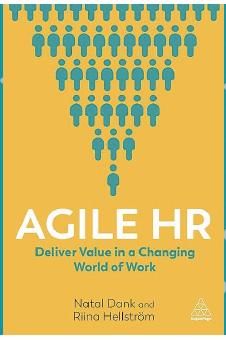By Traci Wallrauch and Tracie Shepherd
A brief review of Part 1 of Dank and Hellstrom’s 2021 book “Agile HR: Deliver Value in a Changing World of Work”
What were you doing in late 2020? Like most, you were probably making radical adjustments due to the COVID-19 pandemic. By this time, coronavirus had exploded across the U.S., forcing schools and businesses to close and segments of the population to social distance or isolate. We experienced a once-in-a-lifetime pandemic that caused alarming health and safety concerns, and created unique circumstances that disrupted life as we knew it – supply chains broke, schools shut down, businesses locked down, massive unemployment, travel at a trickle – and many other “firsts” we hope will never happen again.
Despite the unanticipated threat of a pandemic, hundreds of businesses quickly pivoted, survived and even thrived, while others languished or went under altogether. Although most industries and particular businesses faced various unique challenges, nimble organizations fared much better. They were more accustomed to facing routine change and operational flexibility, collaboratively brainstorming options and solutions, being untethered to stagnant organizational traditions, and generously trusting each other – they were agile.
“Agile HR takes everything we know about the Agile mindset … and translates these concepts into the context of human resources and people operations,” and it begins with healthy talent philosophy (Dank & Hellstrom, 2020, p. 3). Rather than thinking of employees as merely expendable replaceable commodities, practicing Agile HR strategically positions organizational leaders to view employees in a much higher regard – as key stakeholders, co-laborers, co-creators of products, services or change, and as teammates empowered to delight customers. As such, Agile can be encapsulated as prioritizing work based on its value for the customer.
Of consideration are real-time Agile value-adds, benefits and advantages along with anticipated outcomes. Perhaps most important is shared vision: everyone in the organization views customers as the singular priority and focus. This unified customer-centric position helps employees feel connected to purpose and vision. They know their input counts and will involve themselves in co-designing change. Unlike traditional HR with static practices, Agile HR involves a continuous incremental development cycle that flexibly changes with work environments by provoking change through four steps – plan, do, check and act.
Business changes so fast that traditional HR practices make minimal contributions or even impede progress. Agile HR might be the catalyst that inspires an Agile organization. Start by forming small, high-performing teams that understand the end customer. From a people and talent perspective, an enormous change will be adopting a customer-centric approach that seeks input and design co-creation from employees. Operationally, this means HR will establish and support a whole new model of partnering and collaborating with talent throughout the organization. This requires unlearning old habits of top-down decision-making and barking out directives, and instead, authentically seeking feedback from a variety of stakeholders before a solution is implemented.
Even though there’s ample value in practicing Agile HR, the question remains of whether organizations really need to do it. These three points demonstrate such a need:
- In the last 25 years, a seismic shift has been digitization, which puts the customer in charge, and in turn, impacts business and talent management like never before. Consumer preferences shift rapidly, so businesses must likewise shift rapidly. To meet contemporary challenges, organizations, and HR specifically, must replace legacy processes and frameworks – those antiquated ways of doing things or the structures and hierarchies that impede quick pivots, stifle communication, neglect feedback, or disregard a must-add-value attitude for the customer.
- Customers expect us to be quick. Delegated authority should reside with high-performing teams closest to the customer. This reduces decision-making latency and replaces it with relevant and timely decisions, problem-solving and faster speed to market.
- Employees deserve equitable rewards. Long overdue is substitution of the traditional performance-management system. Multi-generational and highly diverse workforces are common, which naturally lead to variation in how work is done and what workers value. Organizations must develop more dynamic and meaningful ways to reward and recognize the contributions of both individual contributors and high-performing teams.
An Agile approach requires a mindset shift and is a major change effort. As such, Agile principles necessitate support from top-level leadership, with corresponding changes in managerial thinking patterns and organizational structures. Agile principles allow HR to modify approaches to work, which lead to added value. But what does it mean to modify approaches to work? It means the way a question, project or problem is approached will be done from a different mindset and in a different manner. For an example, read about Toyota’s embrace of kaizen (https://bit.ly/3XSpNyK) and then watch a video (https://bit.ly/4bwbKSA) about it.
HR’s work environment is not stable or predictable; it’s characterized and impacted by change. Customer needs also change. HR has complex dependencies with other departments or teams that impact decisions, actions and reactions. External disruptions arise like recruitment challenges or union negotiations. Only Agile HR can navigate this fluid landscape by constantly evaluating work approaches against the litmus test of customer needs, complex dependencies and external disruptions, as exemplified in these self-imposed questions:
- In practical adherence or application, do we hamstring employees’ ability to respond to customer needs?
- Do we disregard how the work of one employee group impacts the work of another? Competing priorities or unaligned objectives are counter-productive; employees will unintentionally sabotage each other’s progress.
- Are we apathetic to our external business environment? What HR does inside the organization must be informed by what’s going on outside the organization. For example, if the economy is thriving and jobs are plentiful, that should inform our compensation plan and recruitment efforts.
As you reflect on this article and ponder the questions therein, hopefully, you’ll be inspired to pick up Dank and Hellstrom’s book for a quick, informative and provocative read. You might even find yourselfrecalibrating your own thinking patterns and discovering firsthand the value Agile can bring to your HR team, your organization and, ultimately, the customers you serve. We hope so!

